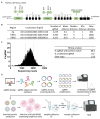Core regions in immunoglobulin heavy chain enhancers essential for survival of non-Hodgkin lymphoma cells are identified by a CRISPR interference screen
- PMID: 38934080
- PMCID: PMC11609794
- DOI: 10.3324/haematol.2023.284672
Core regions in immunoglobulin heavy chain enhancers essential for survival of non-Hodgkin lymphoma cells are identified by a CRISPR interference screen
Abstract
Chromosomal translocations in non-Hodgkin lymphoma (NHL) result in activation of oncogenes by placing them under the regulation of immunoglobulin heavy chain (IGH) super-enhancers. Aberrant expression of translocated oncogenes induced by enhancer activity can contribute to lymphomagenesis. The role of the IGH enhancers in normal B-cell development is well established, but knowledge regarding the precise mechanisms of their involvement in control of the translocated oncogenes is limited. The goal of this project was to define the critical regions in the IGH regulatory elements and identify enhancer RNA (eRNA). We designed a single guide RNA library densely covering the IGH enhancers and performed tiling CRISPR interference screens in three NHL cell lines. This revealed three regions crucial for NHL cell growth. With chromatin- enriched RNA sequencing we showed transcription from the core enhancer regions and subsequently validated expression of the eRNA in a panel of NHL cell lines and tissue samples. Inhibition of the essential IGH enhancer regions decreased expression of eRNA and translocated oncogenes in several NHL cell lines. The observed expression and growth patterns were consistent with the breakpoints in the IGH locus. Moreover, targeting the Eμ enhancer resulted in loss of B-cell receptor expression. In a Burkitt lymphoma cell line, MYC overexpression partially rescued the phenotype induced by IGH enhancer inhibition. Our results indicated the most critical regions in the IGH enhancers and provided new insights into the current understanding of the role of IGH enhancers in B-cell NHL. As such, this study forms a basis for development of potential therapeutic approaches.
Figures





Similar articles
-
7-[[(4-methyl-2-pyridinyl)amino](2-pyridinyl)methyl]-8-quinolinol (compound 30666) inhibits enhancer activity and reduces B-cell lymphoma growth - A question of specificity.Eur J Pharmacol. 2021 Nov 5;910:174505. doi: 10.1016/j.ejphar.2021.174505. Epub 2021 Sep 14. Eur J Pharmacol. 2021. PMID: 34534532
-
Discovery platform for inhibitors of IgH gene enhancer activity.Cancer Biol Ther. 2019;20(4):571-581. doi: 10.1080/15384047.2018.1538615. Epub 2018 Nov 27. Cancer Biol Ther. 2019. PMID: 30481117 Free PMC article.
-
Mouse Models of c-myc Deregulation Driven by IgH Locus Enhancers as Models of B-Cell Lymphomagenesis.Front Immunol. 2020 Jul 23;11:1564. doi: 10.3389/fimmu.2020.01564. eCollection 2020. Front Immunol. 2020. PMID: 32793219 Free PMC article. Review.
-
Regulatory elements in the immunoglobulin heavy chain gene 3'-enhancers induce c-myc deregulation and lymphomagenesis in murine B cells.J Biol Chem. 2005 Apr 1;280(13):12766-73. doi: 10.1074/jbc.M412446200. Epub 2005 Feb 1. J Biol Chem. 2005. PMID: 15687498
-
The IgH 3' regulatory region and c-myc-induced B-cell lymphomagenesis.Oncotarget. 2017 Jan 24;8(4):7059-7067. doi: 10.18632/oncotarget.12535. Oncotarget. 2017. PMID: 27729620 Free PMC article. Review.
Cited by
-
Targeting super-enhancers in liver cancer: from pathogenic mechanisms to clinical applications.Front Pharmacol. 2025 Jun 18;16:1589455. doi: 10.3389/fphar.2025.1589455. eCollection 2025. Front Pharmacol. 2025. PMID: 40606603 Free PMC article. Review.
-
Integrative genomic analysis identifies novel causal genes of Hodgkin's and non-Hodgkin's lymphoma.Discov Oncol. 2025 Jul 13;16(1):1324. doi: 10.1007/s12672-025-03101-1. Discov Oncol. 2025. PMID: 40652422 Free PMC article.
References
-
- Sedeta E, Ilerhunmwuwa N, Wasifuddin M, et al. . Epidemiology of non-Hodgkin lymphoma: global patterns of incidence, mortality, and trends. Blood. 2022;140(Supplement 1):5234-5235.
-
- Küppers R, Dalla-Favera R. Mechanisms of chromosomal translocations in B cell lymphomas. Oncogene. 2001;20(40):5580-5594. - PubMed
MeSH terms
Substances
LinkOut - more resources
Full Text Sources
Molecular Biology Databases
Research Materials

